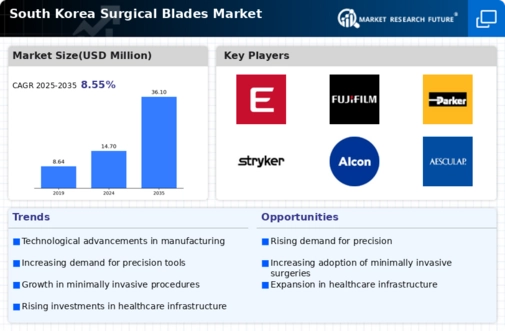Surge in Surgical Procedures
The frequency of surgical procedures in South Korea is on the rise, which serves as a significant driver for the surgical blades market. With advancements in medical technology and an aging population, the number of surgeries performed is expected to increase. In 2025, it is estimated that the country will witness over 1.5 million surgical operations, encompassing various specialties such as orthopedics, cardiology, and general surgery. This surge in surgical activity necessitates a corresponding increase in the supply of surgical blades, as they are essential tools in these procedures. The surgical blades market is likely to experience growth as healthcare providers seek to meet the demands of this expanding surgical landscape. Additionally, the trend towards minimally invasive surgeries may further influence the types of blades required, emphasizing the need for innovation in blade design and functionality.
Increasing Healthcare Expenditure
The rising healthcare expenditure in South Korea is a pivotal driver for the surgical blades market. As the government and private sectors allocate more funds towards healthcare, the demand for surgical instruments, including blades, is likely to increase. In 2025, healthcare spending is projected to reach approximately 9.5% of the GDP, reflecting a growing commitment to improving medical facilities and services. This financial support enables hospitals and clinics to invest in advanced surgical tools, thereby enhancing surgical outcomes. Furthermore, the increasing number of surgical procedures performed annually, estimated to be around 1.2 million, further propels the need for high-quality surgical blades. The surgical blades market is thus positioned to benefit from this upward trend in healthcare investment, as it correlates with the demand for efficient and reliable surgical instruments.
Growing Awareness of Surgical Safety
The growing awareness of surgical safety among healthcare professionals and patients is a crucial driver for the surgical blades market. In South Korea, there is an increasing emphasis on patient safety protocols and the use of high-quality surgical instruments. This heightened awareness is leading to stricter procurement policies within hospitals and surgical centers, where the focus is on acquiring reliable and safe surgical blades. The surgical blades market is likely to see growth as healthcare facilities prioritize the purchase of blades that meet stringent safety standards. Additionally, educational initiatives aimed at promoting best practices in surgical procedures are contributing to this trend, as they encourage the adoption of superior surgical tools. As a result, the demand for blades that ensure optimal performance and safety is expected to rise.
Expansion of Healthcare Infrastructure
The expansion of healthcare infrastructure in South Korea is a significant driver for the surgical blades market. As new hospitals and surgical centers are established, the demand for surgical instruments, including blades, is likely to increase. The South Korean government has been investing heavily in healthcare infrastructure, with plans to enhance facilities and services across the nation. By 2025, it is projected that the number of healthcare facilities will increase by approximately 15%, leading to a higher demand for surgical tools. This growth in infrastructure not only supports the surgical blades market but also encourages the adoption of advanced surgical techniques and technologies. Consequently, the need for high-quality surgical blades that can meet the demands of modern surgical practices is expected to rise.
Technological Innovations in Surgical Instruments
Technological innovations are transforming the surgical blades market, driving demand for advanced surgical instruments. In South Korea, the integration of smart technologies and materials science into surgical blade design is becoming increasingly prevalent. For instance, the development of blades with enhanced sharpness and durability, as well as those that incorporate antimicrobial properties, is gaining traction. These innovations not only improve surgical precision but also reduce the risk of infections, which is a critical concern in surgical settings. The surgical blades market is likely to benefit from these advancements, as healthcare providers prioritize the use of cutting-edge tools that enhance patient safety and surgical outcomes. Furthermore, the introduction of robotic-assisted surgeries may also necessitate specialized blades, further expanding the market's potential.

















Leave a Comment